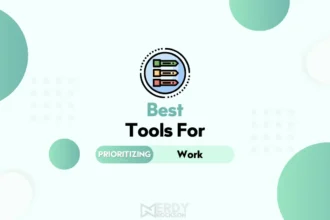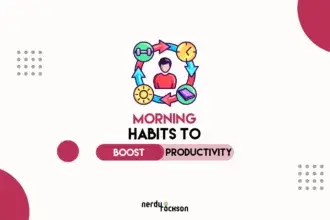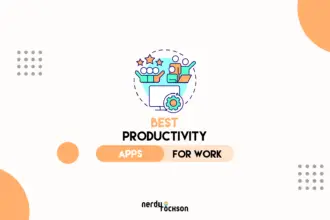Are you struggling to stay focused while working from home? You’re not alone. According to a study featured in Statista, participants in the survey disclosed specific challenges they encountered while working remotely, particularly issues impacting their ability to concentrate, such as home-based distractions. It’s hardly astonishing, given the intertwining of professional commitments and domestic responsibilities, which has made maintaining focus more demanding.
But fear not because we have 10 proven ways to help you stay on track and get your work done efficiently and effectively. So, grab your favorite beverage, find a comfortable spot, and read on for some quick and practical tips to stay focused while working from home.
1. Establishing a Mindset for Productivity
When it comes to staying focused while working from home, establishing the right mindset is key. Without the structure and routine of a traditional office environment, it can be easy to fall into the trap of procrastination or distractions. However, by adopting a productive mindset, you can set yourself up for success and achieve your goals.
One of the first steps in establishing a productivity mindset is to create a dedicated workspace. This can help to signal to your brain that it is time to work and can help minimize distractions. Set up a comfortable and organized area with all the tools and resources you need within reach.
Next, it’s important to set clear goals and priorities for each day. Start by identifying your most important tasks and breaking them down into manageable steps. This will help you stay focused and motivated, as you will have a clear direction and purpose.
Another important aspect of a productivity mindset is to avoid multitasking. While it may seem efficient, multitasking actually decreases productivity and can lead to errors. Instead, focus on one task at a time and give it your full attention. This will help you stay present and engaged, leading to better results.
Lastly, remember to take breaks and give yourself time to recharge. Working nonstop without breaks can lead to burnout and decreased focus. Schedule short breaks throughout your day to rest your mind and body. Use this time to stretch, go for a walk, or do something enjoyable. This will help you return to work with renewed energy and focus.
2. Creating an Optimized Workspace for Better Focus
Having an optimized workspace is crucial for staying focused while working from home. Here are some tips to create an environment that promotes productivity and minimizes distractions:
- Find a dedicated space: Designate a specific area in your home as your workspace. This will help you mentally separate work from leisure and create a sense of structure. Having a designated space also allows you to keep your work materials organized and easily accessible.
- Eliminate distractions: Take steps to minimize distractions in your workspace. Keep your desk clutter-free and only have the essentials within reach. If noise is an issue, consider using noise-cancelling headphones or playing background music that helps you stay focused.
- Ensure good lighting: Natural light is ideal, as it helps improve focus and mood. Position your workspace near a window if possible. If natural light is unavailable, invest in a good desk lamp to provide adequate lighting.
- Make it ergonomic: Ensure that your workspace is set up ergonomically to prevent discomfort and distractions. Invest in an ergonomic chair and adjust your desk and computer setup to promote good posture. This will help reduce the risk of physical discomfort and keep you focused on your work.
- Personalize your space: Make your workspace inviting by adding personal touches. Surround yourself with items that inspire you, such as plants, artwork, or motivational quotes. Creating a space that reflects your personality and interests can help boost your motivation and focus.
By creating an optimized workspace, you can stay focused while working from home and set yourself up for success. Remember to tailor your workspace to your needs and preferences and make adjustments as necessary to optimize your focus and productivity.
3. Scheduling and Structuring Your Workday for Success
Scheduling and structuring your workday is crucial for staying focused while working from home. Without the usual office environment and set working hours, it can be easy to lose track of time and get distracted. Here are some effective strategies to help you stay on track and make the most of your workday:
- Start by creating a daily schedule. Set specific times for starting and ending work, as well as dedicated blocks of time for different tasks or projects. Having a structured schedule will help you stay organized and ensure that you allocate enough time for each task.
- Prioritize your tasks. Identify your most important and urgent tasks and tackle them first. This will help you stay focused on the most crucial work and prevent procrastination.
- Break down your work into manageable chunks. Large tasks can be overwhelming and make it difficult to maintain focus. By breaking them down into smaller, more manageable steps, you’ll feel a sense of progress and accomplishment as you complete each step.
- Use time-blocking techniques. Allocate specific blocks of time for different tasks or types of work. For example, you could dedicate the morning to focused work, the afternoon to meetings and collaboration, and the late afternoon to administrative tasks. Time-blocking helps you stay focused on one task at a time and prevents multitasking.
- Minimize distractions during your scheduled work time. Turn off notifications on your phone, close unnecessary browser tabs, and create a dedicated workspace free from distractions. If necessary, use apps or website blockers to restrict access to distracting websites or social media.
- Take regular breaks. Short breaks throughout the day can actually improve focus and productivity. Use these breaks to stretch, go for a walk, or do something enjoyable. When you return to work, you’ll feel refreshed and ready to tackle the next task.
- Finally, review and adjust your schedule as needed. Pay attention to what works best for you and make adjustments accordingly. Everyone has different peak productivity times and preferences, so find a schedule that suits your needs and maximizes your focus and efficiency.
By implementing these strategies and creating a structured workday, you can stay focused while working from home and make the most of your time and energy.
4. Minimizing Distractions to Maximize Productivity
Working from home comes with its fair share of distractions, which can easily derail your focus and productivity. However, by implementing a few strategies, you can minimize these distractions and maximize your productivity.
First, establish boundaries with family members or roommates. Let them know your working hours and ask for their support in minimizing interruptions. Create a system, such as a closed door or a “do not disturb” sign, to signal when you need uninterrupted time to work.
Next, limit access to social media and other online distractions. Use website blockers or browser extensions to temporarily block access to these sites during your designated work hours. Put your phone on silent or in another room to avoid the temptation of checking notifications.
Designate specific times for checking and responding to emails and messages. Constantly checking your inbox throughout the day can be a major distraction. Instead, schedule designated times to deal with emails and messages, allowing you to focus on more important tasks during the rest of your workday.
It’s also important to create a clutter-free workspace. Clear away any unnecessary items that can visually distract you. Keep your desk organized and tidy so you can easily find what you need without wasting time or getting sidetracked.
Finally, if noise is a distraction for you, consider using noise-cancelling headphones or playing background music that helps you focus. Experiment with different soundscapes, such as nature sounds or instrumental music, to find what works best for you.
5. Utilizing Productivity Tools and Apps to Stay on Track
Utilizing productivity tools and apps can be a game-changer when it comes to staying focused and organized while working from home. These tools can help streamline your tasks, manage your time more effectively, and eliminate distractions. Here are a few productivity tools and apps that can help you stay on track:
- Task management apps: Use apps like Trello, Asana, or Todoist to create to-do lists, set deadlines, and prioritize tasks. These apps allow you to organize your projects and track your progress, ensuring that nothing falls through the cracks.
- Time tracking apps: Tools like RescueTime or Toggl can help you monitor how you spend your time throughout the day. By tracking your time, you can identify patterns and areas where you may be wasting time. This knowledge can help you make adjustments and allocate your time more efficiently.
- Focus and productivity apps: Apps like Forest, Freedom, or StayFocusd can help you block distracting websites and apps, allowing you to stay focused on your work. These apps use techniques like gamification or website blocking to keep you on track and minimize digital distractions.
- Communication and collaboration tools: Tools like Slack or Microsoft Teams can streamline communication with colleagues, allowing you to stay connected and collaborate effectively. These platforms offer features like instant messaging, video conferencing, and file sharing, making remote collaboration seamless.
- Note-taking apps: Apps like Evernote or Notion can help you capture ideas, create to-do lists, and organize your notes. These apps allow you to access your information across devices and keep all your important information in one place.
By utilizing these productivity tools and apps, you can enhance your focus, streamline your tasks, and boost your overall productivity while working from home. Experiment with different tools and find the ones that work best for your needs and workflow. With the right tools at your disposal, you can stay on track and achieve your professional goals with ease.
6. Incorporating Movement and Exercise into Your Workday
Amid a busy workday, it’s important to prioritize movement and exercise to enhance focus and overall well-being. While working from home, it can be tempting to remain sedentary for long periods, but this can lead to decreased productivity and energy levels. By incorporating regular movement and exercise into your workday, you can boost your focus and improve your overall health.
One way to incorporate movement into your workday is by taking short active breaks. These breaks can include activities such as:
- Stretching: Stand up and stretch your body, focusing on areas like your neck, shoulders, back, and legs. Simple stretches can help relieve tension and increase blood flow, improving focus and reducing the risk of muscle stiffness.
- Walking or jogging in place: Take a quick walk or jog in place for a few minutes to get your blood flowing and increase your energy levels. This can help wake up your body and mind, promoting focus and alertness.
- Desk exercises: Incorporate simple exercises that can be done at your desk, such as leg raises, calf raises, or desk push-ups. These exercises engage your muscles and promote blood circulation, keeping you active and focused throughout the day.
Additionally, scheduling time for more intense workouts outside of your work hours can also be beneficial. This can include activities such as:
- Cardio exercises: Engage in activities like running, cycling, or dancing that elevate your heart rate and get your body moving. Cardiovascular exercise releases endorphins, which can boost your mood and mental clarity, leading to improved focus.
- Strength training: Incorporate strength training exercises using resistance bands, dumbbells, or bodyweight exercises. Building strength can improve overall stamina and increase energy levels, enhancing your ability to stay focused and productive.
Remember, the key is to find activities that you enjoy and can realistically fit into your workday. Experiment with different exercises and find a routine that works for you. By incorporating movement and exercise into your workday, you can enhance your focus, productivity, and overall well-being.
7. Prioritizing Self-Care and Mental Health for Long-Term Focus
In the hustle and bustle of working from home, it’s easy to neglect self-care and mental health. However, prioritizing these aspects is crucial for maintaining long-term focus and productivity. When you take care of yourself, both physically and mentally, you’re better equipped to tackle the challenges of remote work and stay focused on your goals.
Start by establishing a self-care routine that works for you. This may include activities like exercise, meditation, journaling, or simply taking time for yourself. Find what helps you relax and recharge, and make it a non-negotiable part of your daily routine.
It’s also important to set boundaries between work and personal life. When you work from home, it can be easy for the lines to blur, leading to burnout and decreased focus. Set specific working hours and stick to them, avoiding the temptation to check emails or complete tasks outside of these hours. Give yourself permission to disconnect and prioritize your own well-being.
Additionally, make time for social connection. Working remotely can be isolating, so it’s important to maintain relationships with colleagues, friends, and family. Schedule virtual coffee breaks or lunch dates, participate in online communities or forums, and make an effort to connect with others regularly. These connections can help boost your mood, provide support, and increase your motivation to stay focused.
8. Ensuring Adequate Sleep and Relaxation
In the hustle and bustle of working from home, it’s easy to forget about the importance of getting enough sleep and taking time to relax. However, ensuring adequate sleep and relaxation is crucial for maintaining long-term focus and productivity. When you’re well-rested and relaxed, you have the energy and mental clarity to tackle your work with efficiency and creativity.
One of the first steps in ensuring adequate sleep is to establish a consistent sleep schedule. Try to go to bed and wake up at the same time every day, even on weekends. This helps regulate your body’s internal clock and ensures that you’re getting the recommended seven to eight hours of sleep each night.
In addition to a consistent sleep schedule, it’s important to create a relaxing bedtime routine. Engage in activities that help signal to your body that it’s time to wind down, such as reading a book, taking a warm bath, or practicing relaxation techniques like deep breathing or meditation. Avoid stimulating activities or electronics in the hour leading up to bedtime, as these can interfere with your ability to fall asleep.
Throughout the day, make sure to take regular breaks to relax and recharge. Incorporate activities that help you de-stress, such as going for a walk, practicing yoga, or listening to calming music. Taking these moments for yourself not only promotes relaxation but also helps prevent burnout and allows your mind to recharge.
9. Maximizing Your Breaks for Optimal Focus
In the midst of a busy workday, it’s important to remember the value of taking breaks. Many people believe that pushing through without breaks is the key to being productive, but the truth is that breaks can actually enhance your focus and overall productivity. When utilized correctly, breaks can be a valuable tool in optimizing your work performance while working from home.
One effective strategy for maximizing your breaks is the Pomodoro Technique. This technique involves working for a focused period of time, typically 25 minutes, followed by a short break of 5 minutes. After completing four cycles, take a longer break of around 15-30 minutes. This method helps to combat mental fatigue and maintain high levels of focus.
During your breaks, it’s important to engage in activities that help you relax and recharge. Step away from your workspace and do something completely unrelated to work. Stretch your legs, go for a walk outside, do some deep breathing exercises, or listen to your favorite music. These activities can help clear your mind, reduce stress, and rejuvenate your focus.
Another effective way to maximize your breaks is to practice mindfulness or meditation. Taking a few minutes to sit quietly and focus on your breath can help calm your mind, improve concentration, and boost your overall well-being. There are many meditation apps available that provide guided sessions specifically designed for short breaks, making it easy to incorporate this practice into your work routine.
In addition, using your breaks to engage in physical activity can have a profound impact on your focus and productivity. Consider incorporating short bursts of exercise, such as a quick workout routine or a few minutes of yoga, to get your blood flowing and increase your energy levels. Physical activity releases endorphins, which can help boost your mood and mental clarity.
When it comes to breaks, it’s important to be mindful of how you spend them. Avoid mindlessly scrolling through social media or engaging in activities that are mentally draining. Instead, use your breaks as an opportunity to recharge and refocus your mind.
10. Setting Realistic Goals for Motivation
Setting realistic goals is an important aspect of staying focused and motivated while working from home. When you have clear goals in mind, you have something to strive for and can stay on track with your work. However, it’s essential to set goals that are realistic and attainable to avoid feeling overwhelmed or discouraged.
To set realistic goals, start by breaking down larger tasks into smaller, manageable steps. This will make your goals more achievable and less overwhelming. It’s also helpful to prioritize your tasks based on importance and deadlines. This will ensure that you focus on the most critical tasks first and maintain momentum.
When setting goals, consider your limitations and resources. Be honest with yourself about what you can realistically accomplish within a given timeframe. Setting goals that are too ambitious can lead to burnout and decreased motivation. Remember, it’s better to set smaller, achievable goals that you can consistently reach than to set unrealistic goals that are unattainable.
Additionally, it’s important to track your progress and celebrate your achievements along the way. This will help you stay motivated and give you a sense of accomplishment. Regularly reviewing and adjusting your goals is also essential, as circumstances and priorities can change over time.
Conclusion
By implementing these ten proven strategies, individuals can overcome the challenges of working from home and achieve their professional goals with focus and efficiency. Staying focused while working from home is a manageable task when the right mindset, workspace, routines, and self-care practices are in place.










This website truly has all the information and facts I needed about this subject and
didn’t know who to ask.
Hi friends, its wonderful article about educationand fully explained, keep it up all the time.
Heya i’m for the first time here. I found this board and I
find It really useful & it helped me out a lot. I hope to give something back and aid
others like you helped me.